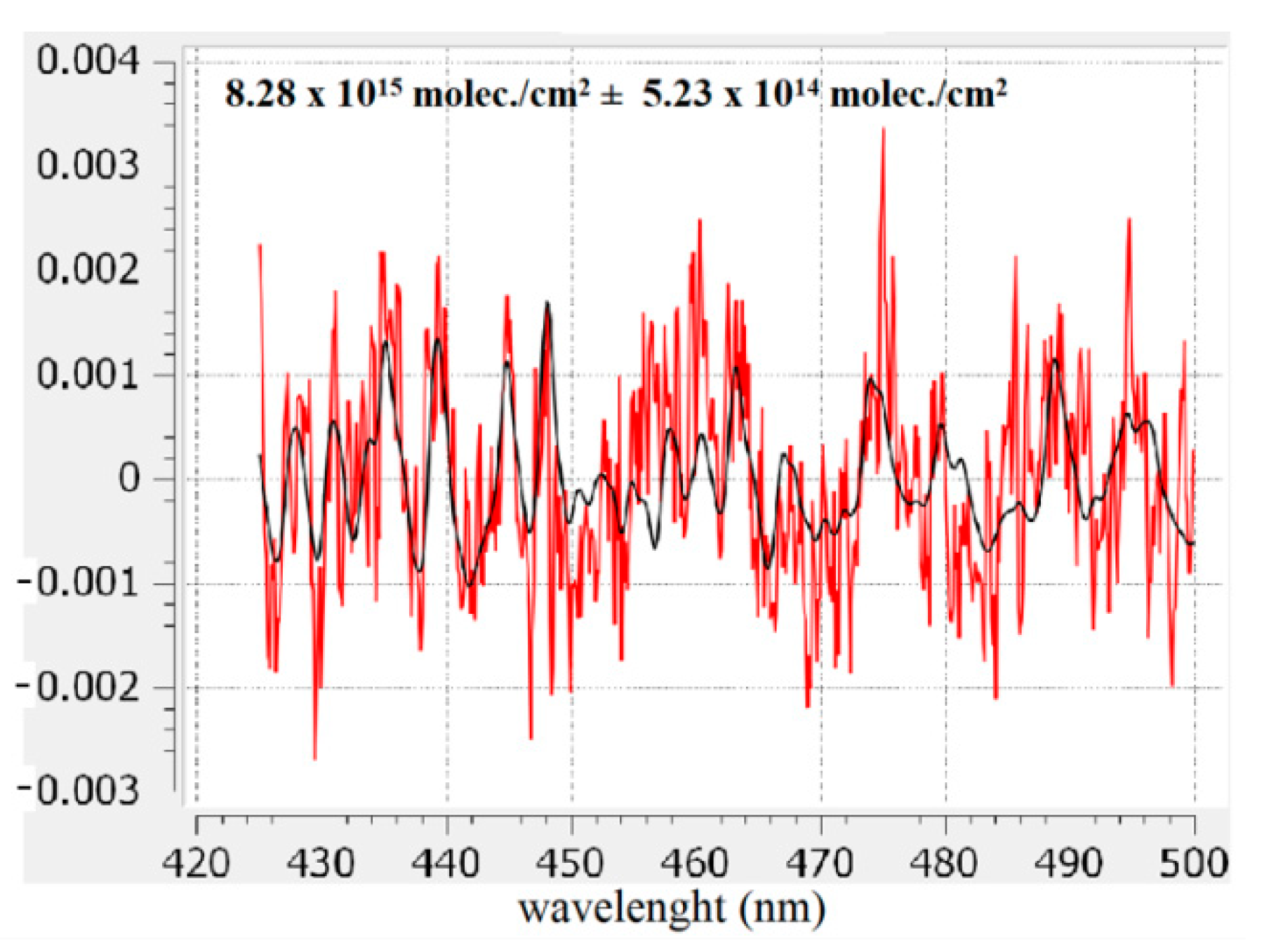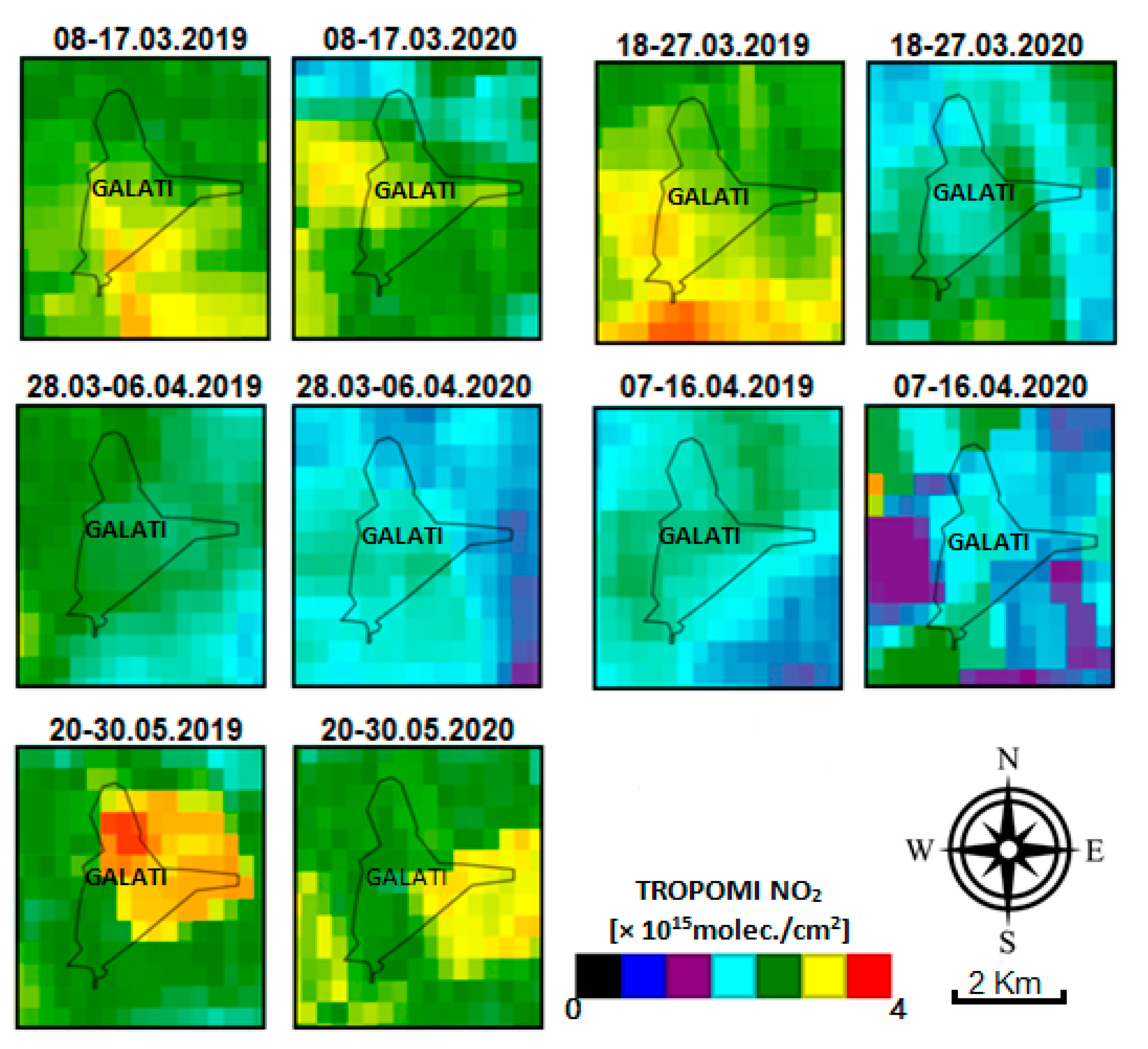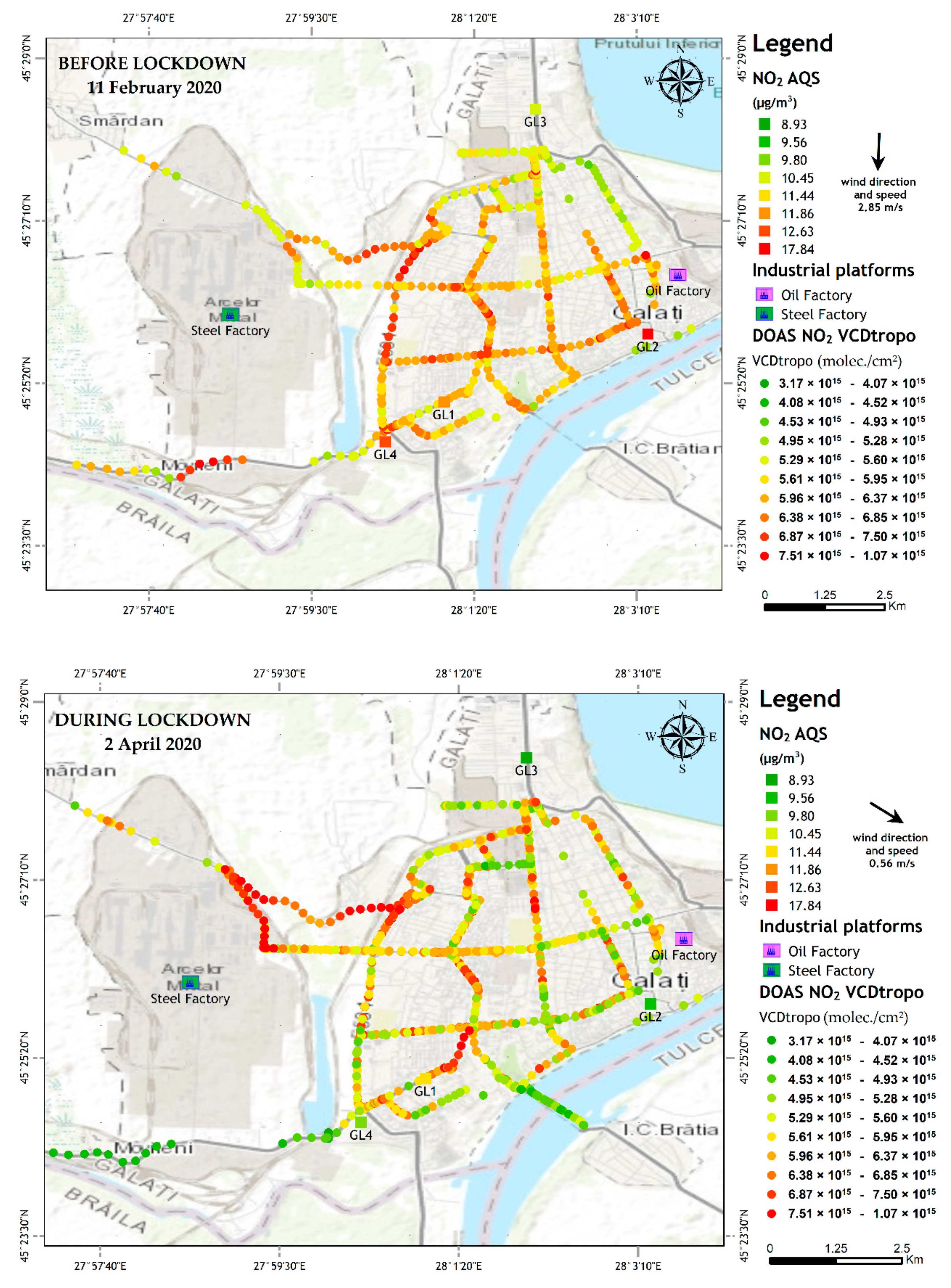Assessment of NO2 Pollution Level during the COVID-19 Lockdown in a Romanian City
Abstract
:1. Introduction
2. Data and Methodology
2.1. Instrument Description: Mobile DOAS System
2.2. DOAS Spectral Analysis and Retrieval of NO2 Vertical Column Densities
2.3. Instrument Description: Air Quality Monitoring Stations (AQMS)
2.4. The Track of the Mobile DOAS and Location of the Local AQMS
3. Results and Discussion
3.1. Analysis of In Situ NO2 Concentrations for the First Six Months of 2019 versus 2020
3.2. Spatial Comparison of NO2 Emissions Measured by AQMS and the UGAL Mobile DOAS System
4. Conclusions
Author Contributions
Funding
Institutional Review Board Statement
Informed Consent Statement
Data Availability Statement
Acknowledgments
Conflicts of Interest
References
- Coronavirus Disease (COVID-19) Situation Reports. Available online: https://www.who.int/emergencies/diseases/novel-coronavirus-2019/situation-reports/ (accessed on 6 October 2020).
- Lai, C.C.; Shih, T.P.; Ko, W.C.; Tang, H.J.; Hsueh, P.R. Severe acute respiratory syndrome coronavirus 2 (SARS-CoV-2) and coronavirus disease-2019 (COVID-19): The epidemic and the challenges. Int. J. Antimicrob. Agents 2020, 105924. [Google Scholar] [CrossRef] [PubMed]
- Lenzen, M.; Li, M.; Malik, A.; Pomponi, F.; Sun, Y.Y.; Wiedmann, T.; Faturay, F.; Fry, J.; Gallego, B.; Geschke, A.; et al. Global socio-economic losses and environmental gains from the coronavirus pandemic. PLoS ONE 2020, 15, e0235654. [Google Scholar] [CrossRef] [PubMed]
- Romania: WHO Coronavirus Disease (COVID-19) Dashboard|WHO Coronavirus Disease (COVID-19) Dashboard. Available online: https://covid19.who.int/region/euro/country/ro (accessed on 18 August 2020).
- Merlaud, A.; Belegante, L.; Constantin, D.E.; Den Hoed, M.; Carlos Meier, A.; Allaart, M.; Ardelean, M.; Arseni, M.; Bösch, T.; Brenot, H.; et al. Satellite validation strategy assessments based on the AROMAT campaigns. Atmos. Meas. Tech. 2020, 13, 5513–5535. [Google Scholar] [CrossRef]
- Crippa, M.; Guizzardi, D.; Muntean, M.; Schaaf, E.; Dentener, F.; van Aardenne, J.A.; Monni, S.; Doering, U.; Olivier, J.G.J.; Pagliari, V.; et al. Gridded emissions of air pollutants for the period 1970–2012 within EDGAR v4.3.2. Earth Syst. Sci. Data 2018, 10, 1987–2013. [Google Scholar] [CrossRef] [Green Version]
- Trombetti, M.; Thunis, P.; Bessagnet, B.; Clappier, A.; Couvidat, F.; Guevara, M.; Kuenen, J.; López-Aparicio, S. Spatial inter-comparison of Top-down emission inventories in European urban areas. Atmos. Environ. 2018, 173, 142–156. [Google Scholar] [CrossRef]
- Collivignarelli, M.C.; Abbà, A.; Bertanza, G.; Pedrazzani, R.; Ricciardi, P.; Carnevale Miino, M. Lockdown for CoViD-2019 in Milan: What are the effects on air quality? Sci. Total Environ. 2020, 732, 139280. [Google Scholar] [CrossRef]
- Mahato, S.; Pal, S.; Ghosh, K.G. Effect of lockdown amid COVID-19 pandemic on air quality of the megacity Delhi, India. Sci. Total Environ. 2020, 732, 139280. [Google Scholar] [CrossRef]
- Voiculescu, M.; Constantin, D.E.; Condurache-Bota, S.; Călmuc, V.; Roșu, A.; Bălănică, C.M.D. Role of meteorological parameters in the diurnal and seasonal variation of NO2 in a Romanian urban environment. Int. J. Environ. Res. Public Health 2020, 17, 6228. [Google Scholar] [CrossRef]
- Constantin, D.E.; Bocăneala, C.; Voiculescu, M.; Roşu, A.; Merlaud, A.; Van Roozendael, M.; Georgescu, P.L. Evolution of SO2 and NOx emissions from several large combustion plants in europe during 2005–2015. Int. J. Environ. Res. Public Health 2020, 17, 3630. [Google Scholar] [CrossRef]
- Constantin, D.E.; Merlaud, A.; Van Roozendael, M.; Voiculescu, M.; Fayt, C.; Hendrick, F.; Pinardi, G.; Georgescu, L. Measurements of tropospheric NO2 in Romania using a zenith-sky mobile DOAS system and comparisons with satellite observations. Sensors 2013, 13, 3922–3940. [Google Scholar] [CrossRef] [Green Version]
- Dragomir, C.M.; Constantin, D.E.; Voiculescu, M.; Georgescu, L.P.; Merlaud, A.; Van Roozendael, M. Modeling results of atmospheric dispersion of NO2 in an urban area using METI–LIS and comparison with coincident mobile DOAS measurements. Atmos. Pollut. Res. 2015, 6, 503–510. [Google Scholar] [CrossRef] [Green Version]
- Roșu, A. Utilization of the Differential Optical Absorption Spectroscopy in Quantification of Atmospheric Pollution with Nitrogen Dioxide. Ph.D. Thesis, University “Dunărea de Jos”, Galati, Romania, 2018. [Google Scholar]
- Roşu, A.; Constantin, D.E.; Voiculescu, M.; Arseni, M.; Merlaud, A.; Van Roozendael, M.; Georgescu, P.L. Observations of atmospheric NO2 using a new low-cost MAX-DOAS system. Atmosphere 2020, 11, 129. [Google Scholar] [CrossRef] [Green Version]
- Constantin, D.E.; Merlaud, A.; Voiculescu, M.; Dragomir, C.; Georgescu, L.; Hendrick, F.; Pinardi, G.; Van Roozendael, M. Mobile DOAS observations of tropospheric NO2 using an ultralight trike and flux calculation. Atmosphere 2017, 8, 78. [Google Scholar] [CrossRef] [Green Version]
- Constantin, D.E.; Merlaud, A.; Voiculescu, M.; Van Roozendael, M.; Arseni, M.; Rosu, A.; Georgescu, L. NO2 and SO2 observations in southeast Europe using mobile DOAS observations. Carpathian J. Earth Environ. Sci. 2017, 12, 323–328. [Google Scholar]
- Platt, U.; Stutz, J. Differential Absorption Spectroscopy. In Differential Optical Absorption Spectroscopy; Springer: Berlin/Heidelberg, Germany, 2008. [Google Scholar]
- Carlos Meier, A.; Schönhardt, A.; Bösch, T.; Richter, A.; Seyler, A.; Ruhtz, T.; Constantin, D.E.; Shaiganfar, R.; Wagner, T.; Merlaud, A.; et al. High-resolution airborne imaging DOAS measurements of NO2 above Bucharest during AROMAT. Atmos. Meas. Tech. 2017, 10, 1831–1857. [Google Scholar] [CrossRef] [Green Version]
- Fayt, C.; de Smedt, I.; Letocart, V.; Merlaud, A.; van Pinardi, G.R.M. QDOAS Software User Manual; QDOAS: Brussels, Belgium, 2011. [Google Scholar]
- Merlaud, A.; Tack, F.; Van Roozendael, M.; Constantin, D.; Rosu, A.; Riffel, K.; Donner, S.; Wagner, T.; Schreier, S.; Richter, A.; et al. Synergetic use of the Mobile-DOAS measurements during CINDI-2. In Proceedings of the EGU General Assembly Conference Abstracts, Vienna, Austria, 7–12 April 2018; Volume 20, p. 18038. [Google Scholar]
- Platt, U. The application of differential optical absorption spectroscopy (DOAS) from space. Cosp 2002, 34, 2509. [Google Scholar]
- Vandaele, A.C.; Hermans, C.; Simon, P.C.; Carleer, M.; Colin, R.; Fally, S.; Mérienne, M.F.; Jenouvrier, A.; Coquart, B. Measurements of the NO2 absorption cross-section from 42 000 cm-1 to 10 000 cm-1 (238-1000 nm) at 220 K and 294 K. J. Quant. Spectrosc. Radiat. Transf. 1998, 59, 171–184. [Google Scholar] [CrossRef] [Green Version]
- Bogumil, K.; Orphal, J.; Burrows, J.P. Temperature dependent absorption cross sections of O3, NO2, and other atmospheric trace gases measured with the SCIAMACHY spectrometer. In Proceedings of the ERS-Envisat-Symposium, Goteborg, Sweden, 16–20 October 2000. [Google Scholar]
- Thalman, R.; Zarzana, K.J.; Tolbert, M.A.; Volkamer, R. Rayleigh scattering cross-section measurements of nitrogen, argon, oxygen and air. J. Quant. Spectrosc. Radiat. Transf. 2014, 147, 171–177. [Google Scholar] [CrossRef]
- Chance, K.V.; Spurr, R.J.D. Ring effect studies: Rayleigh scattering, including molecular parameters for rotational Raman scattering, and the Fraunhofer spectrum. Appl. Opt. 1997, 36, 5224–5230. [Google Scholar] [CrossRef] [Green Version]
- Rothman, L.S.; Gordon, I.E.; Barber, R.J.; Dothe, H.; Gamache, R.R.; Goldman, A.; Perevalov, V.I.; Tashkun, S.A.; Tennyson, J. HITEMP, the high-temperature molecular spectroscopic database. J. Quant. Spectrosc. Radiat. Transf. 2010, 111, 2139–2150. [Google Scholar] [CrossRef]
- Stamnes, K.; Tsay, S.; Istvan, L. DISORT, a general-purpose Fortran program for discrete-ordinate-method radiative transfer in scattering and emitting layered media: Documentation of methodology. DISORT Rep. 2000. [Google Scholar] [CrossRef]
- Stamnes, K.; Tsay, S.-C.; Wiscombe, W.; Jayaweera, K. Numerically stable algorithm for discrete-ordinate-method radiative transfer in multiple scattering and emitting layered media. Appl. Opt. 1988, 27, 2502–2509. [Google Scholar] [CrossRef] [PubMed]
- Hendrick, F.; Van Roozendael, M.; Kylling, A.; Petritoli, A.; Rozanov, A.; Sanghavi, S.; Schofield, R.; von Friedeburg, C.; Wagner, T.; Wittrock, F.; et al. Intercomparison exercise between different radiative transfer models used for the interpretation of ground-based zenith-sky and multi-axis DOAS observations. Atmos. Chem. Phys. 2006, 6, 93–108. [Google Scholar] [CrossRef] [Green Version]
- Boersma, K.F.; Eskes, H.J.; Veefkind, J.P.; Brinksma, E.J.; Van Der A, R.J.; Sneep, M.; Van Den Oord, G.H.J.; Levelt, P.F.; Stammes, P.; Gleason, J.F.; et al. Near-real time retrieval of tropospheric NO2 from OMI. Atmos. Chem. Phys. 2007, 7, 2103–2118. [Google Scholar] [CrossRef] [Green Version]
- Regional Tropospheric NO2 Columns from OMI. Available online: http://www.temis.nl/airpollution/no2col/no2regioomi_v2.php (accessed on 7 January 2021).
- Calitate Aer Rețeaua Națională de Monitorizare a Calității Aerului Home Page. Available online: http://calitateaer.ro/public/monitoring-page/reports-reports-page/?__locale=ro (accessed on 16 August 2020).
- Preliminary Report for Air Quality in 2019. Available online: http://www.anpm.ro/documents/19877/47671424/raport+preliminar+CA_2019.pdf/469b6368-7406-4478-944a-5c3583656e96 (accessed on 16 August 2020).
- Stephenson, L. A & B Series Nitrogen Oxides Analyser Service Manual Revision: E. Available online: www.ecotech.com (accessed on 16 August 2020).
- MTX—Compact Weather Station Manual. Available online: http://www.mtx.it/en/products/sensors/compact-weather-station/222-compact-weather-station.html (accessed on 16 August 2020).
- Copernicus Sentinel Data (2019–2020) for Sentinel-5P OFFL NO2: Offline Nitrogen Dioxide. Available online: https://developers.google.com/earth-engine/datasets/catalog/COPERNICUS_S5P_OFFL_L3_NO2#description (accessed on 25 November 2020).
- Veefkind, J.P.; Aben, I.; McMullan, K.; Förster, H.; de Vries, J.; Otter, G.; Claas, J.; Eskes, H.J.; de Haan, J.F.; Kleipool, Q.; et al. TROPOMI on the ESA Sentinel-5 Precursor: A GMES mission for global observations of the atmospheric composition for climate, air quality and ozone layer applications. Remote Sens. Environ. 2012, 120, 70–83. [Google Scholar] [CrossRef]
- Dimitropoulou, E.; Hendrick, F.; Pinardi, G.; Friedrich, M.M.; Merlaud, A.; Tack, F.; De Longueville, H.; Fayt, C.; Hermans, C.; Laffineur, Q.; et al. Validation of TROPOMI tropospheric NO2 columns using dual-scan multi-axis differential optical absorption spectroscopy (MAX-DOAS) measurements in Uccle, Brussels. Atmos. Meas. Tech. 2020, 13, 5165–5191. [Google Scholar] [CrossRef]
- Bao, R.; Zhang, A. Does lockdown reduce air pollution? Evidence from 44 cities in northern China. Sci. Total Environ. 2020, 731, 139052. [Google Scholar] [CrossRef]
- ESA—Air Pollution Remains Low as Europeans Stay at Home. Available online: https://www.esa.int/Applications/Observing_the_Earth/Copernicus/Sentinel-5P/Air_pollution_remains_low_as_Europeans_stay_at_home (accessed on 6 October 2020).
- Jiang, Y.; Wu, X.J.; Guan, Y.J. Effect of ambient air pollutants and meteorological variables on COVID-19 incidence. Infect. Control Hosp. Epidemiol. 2020, 41, 1011–1015. [Google Scholar] [CrossRef]
- Bashir, M.F.; MA, B.J.; Bilal; Komal, B.; Bashir, M.A.; Farooq, T.H.; Iqbal, N.; Bashir, M. Correlation between environmental pollution indicators and COVID-19 pandemic: A brief study in Californian context. Environ. Res. 2020, 187, 109652. [Google Scholar] [CrossRef]
- Environmental Effects of Coronavirus Quarantines. Available online: https://earthobservatory.nasa.gov/images/event/146381/environmental-effects-of-coronavirus-quarantines (accessed on 6 October 2020).
- Sharma, S.; Zhang, M.; Anshika; Gao, J.; Zhang, H.; Kota, S.H. Effect of restricted emissions during COVID-19 on air quality in India. Sci. Total Environ. 2020, 728, 138878. [Google Scholar] [CrossRef]
- Nakada, L.Y.K.; Urban, R.C. COVID-19 pandemic: Impacts on the air quality during the partial lockdown in São Paulo state, Brazil. Sci. Total Environ. 2020, 730, 139087. [Google Scholar] [CrossRef] [PubMed]
- Baldasano, J.M. COVID-19 lockdown effects on air quality by NO2 in the cities of Barcelona and Madrid (Spain). Sci. Total Environ. 2020, 741, 140353. [Google Scholar] [CrossRef] [PubMed]
- Berman, J.D.; Ebisu, K. Changes in U.S. air pollution during the COVID-19 pandemic. Sci. Total Environ. 2020, 739, 139864. [Google Scholar] [CrossRef]
- Dantas, G.; Siciliano, B.; França, B.B.; da Silva, C.M.; Arbilla, G. The impact of COVID-19 partial lockdown on the air quality of the city of Rio de Janeiro, Brazil. Sci. Total Environ. 2020, 729, 139085. [Google Scholar] [CrossRef]
- Wu, X.; Nethery, R.C.; Sabath, B.M.; Braun, D.; Dominici, F. Exposure to air pollution and COVID-19 mortality in the United States. medRxiv 2020. [Google Scholar] [CrossRef] [Green Version]
- Menut, L.; Bessagnet, B.; Siour, G.; Mailler, S.; Pennel, R.; Cholakian, A. Impact of lockdown measures to combat Covid-19 on air quality over western Europe. Sci. Total Environ. 2020, 741, 140426. [Google Scholar] [CrossRef] [PubMed]
- Vîrghileanu, M.; Săvulescu, I.; Mihai, B.-A.; Nistor, C.; Dobre, R. Nitrogen Dioxide (NO2) Pollution Monitoring with Sentinel-5P Satellite Imagery over Europe during the Coronavirus Pandemic Outbreak. Remote Sens. 2020, 12, 3575. [Google Scholar] [CrossRef]









| Absorption Cross-Sections | Temperature | Reference |
|---|---|---|
| NO2 | 298 K | [23] |
| O3 | 293 K | [24] |
| O4 | 293 K | [25] |
| Ring | Not available | [26] |
| H2O | 296 K | [27] |
| Polynomial order | 5 | |
| Fitting window | 425–495 nm | |
| Station Type | Station Code | Estimated Range of Detection Maximum (km) | Estimated Range of Detection Minimum (km) | Latitude N (Decimal Degrees) | Longitude E (Decimal Degrees) |
|---|---|---|---|---|---|
| Traffic | GL1 | 0.1 | 0.01 | 45.41868 | 28.016577 |
| Urban | GL2 | 5 | 1 | 45.43146 | 28.054877 |
| Suburban | GL3 | 5 | 1 | 45.47377 | 28.033728 |
| Industrial | GL4 | 1 | 0.01 | 45.41117 | 28.005526 |
| Date | Measurement Unit | Measured NO2 | Observations Type | ||
|---|---|---|---|---|---|
| Minimum | Average | Maximum | |||
| ×1015 molec./cm2 | 4.89 ± 0.44 | 6.04 ± 0.54 | 10.71 ± 0.96 | Mobile DOAS | |
| µg/m3 | 9.29 ± 0.98 | 11.86 ± 1.26 | 13.63 ± 1.44 | in situ GL1 | |
| 11 February 2020 | µg/m3 | 11.36 ± 1.20 | 12.63 ± 1.34 | 14.52 ± 1.54 | in situ GL2 |
| µg/m3 | 15.15 ± 1.61 | 17.84 ± 1.95 | 23.74 ± 2.52 | in situ GL3 | |
| µg/m3 | 9.58 ± 1.02 | 10.45 ± 1.13 | 12.25 ± 1.30 | in situ GL4 | |
| ×1015 molec./cm2 | 4.40 ± 0.39 | 5.80 ± 0.52 | 8.28 ± 0.74 | Mobile DOAS | |
| µg/m3 | 8.52 ± 0.90 | 9.80 ± 1.05 | 11.25 ± 1.19 | in situ GL1 | |
| 2 April 2020 | µg/m3 | 6.52 ± 0.69 | 8.93 ± 1.01 | 11.52 ± 1.22 | in situ GL2 |
| µg/m3 | 9.14 ± 0.97 | 11.44 ± 1.26 | 17.43 ± 1.85 | in situ GL3 | |
| µg/m3 | 8.02 ± 0.85 | 9.63 ± 1.03 | 11.89 ± 1.26 | in situ GL4 | |
Publisher’s Note: MDPI stays neutral with regard to jurisdictional claims in published maps and institutional affiliations. |
© 2021 by the authors. Licensee MDPI, Basel, Switzerland. This article is an open access article distributed under the terms and conditions of the Creative Commons Attribution (CC BY) license (http://creativecommons.org/licenses/by/4.0/).
Share and Cite
Roșu, A.; Constantin, D.-E.; Voiculescu, M.; Arseni, M.; Roșu, B.; Merlaud, A.; Van Roozendael, M.; Georgescu, P.L. Assessment of NO2 Pollution Level during the COVID-19 Lockdown in a Romanian City. Int. J. Environ. Res. Public Health 2021, 18, 544. https://doi.org/10.3390/ijerph18020544
Roșu A, Constantin D-E, Voiculescu M, Arseni M, Roșu B, Merlaud A, Van Roozendael M, Georgescu PL. Assessment of NO2 Pollution Level during the COVID-19 Lockdown in a Romanian City. International Journal of Environmental Research and Public Health. 2021; 18(2):544. https://doi.org/10.3390/ijerph18020544
Chicago/Turabian StyleRoșu, Adrian, Daniel-Eduard Constantin, Mirela Voiculescu, Maxim Arseni, Bogdan Roșu, Alexis Merlaud, Michel Van Roozendael, and Puiu Lucian Georgescu. 2021. "Assessment of NO2 Pollution Level during the COVID-19 Lockdown in a Romanian City" International Journal of Environmental Research and Public Health 18, no. 2: 544. https://doi.org/10.3390/ijerph18020544
APA StyleRoșu, A., Constantin, D.-E., Voiculescu, M., Arseni, M., Roșu, B., Merlaud, A., Van Roozendael, M., & Georgescu, P. L. (2021). Assessment of NO2 Pollution Level during the COVID-19 Lockdown in a Romanian City. International Journal of Environmental Research and Public Health, 18(2), 544. https://doi.org/10.3390/ijerph18020544





